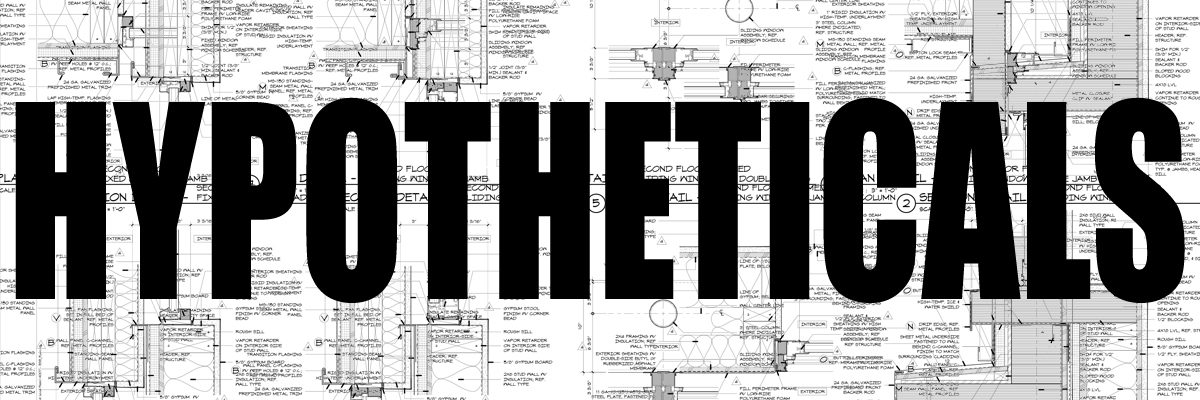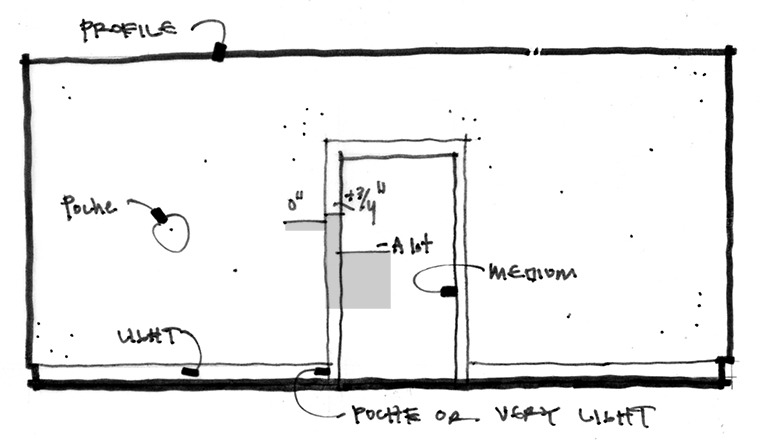Do Architects have obsessive personalities? I tend to think so, and only partially based on my own behavior. I should throw out the caveat that I don’t think you should have to explain why you obsess over something. Isn’t that the nature of any obsession – that there is some level of irrationality associated behind it? Of course, people seem to typically feel that their logic is flawless and that they are completely justified in their behavior and if you can’t see the wisdom in their position, the fault lies with you.
[Note: If you are reading this via email, click here to access the on-site audio player]
Podcast: Embed
Subscribe: Apple Podcasts | Spotify | Android | iHeartRadio | TuneIn
[hoops name=”top1″]

Difference between OCD and OCPD [03:30 mark]
As we launch into a conversation about obsession, it made sense to me to start with a little knowledge before we launch into the items that we obsess over in our daily lives. Have you ever heard of obsessive-compulsive personality disorder, or OCPD? The National Institutes of Health (NIH) describes OCPD as “a mental health condition in which a person is preoccupied with rules, orderliness, and control.” … Doesn’t that sound like every architect you have ever met?!?
OCPD has some of the same symptoms as obsessive-compulsive disorder (OCD). People with OCD have unwanted thoughts, while people with OCPD believe that their thoughts are correct. In addition, OCD often begins in childhood while OCPD usually starts in the teen years or early 20s.
People with either OCPD or OCD are high achievers and feel a sense of urgency about their actions. They may become very upset if other people interfere with their rigid routines. They may not be able to express their anger directly. People with OCPD have feelings that they consider more appropriate, like anxiety or frustration.
A person with OCPD has symptoms of perfectionism that usually begin by early adulthood. This perfectionism may interfere with the person’s ability to complete tasks because their standards are so rigid. They may withdraw emotionally when they are not able to control the situation. This can interfere with their ability to solve problems and form close relationships.1
Other signs of OCPD include:
- Over-devotion to work
- Not being able to throw things away, even when the objects have no value
- Lack of flexibility
- Lack of generosity
- Not wanting to allow other people to do things
- Not willing to show affection
- Preoccupation with details, rules, and lists
Further Reading Worth Your Time [05:27 mark]
If you want to learn a bit more on this, you can read a book that I read an interesting book authored by Joshua Kendall titled “America’s Obsessives: The Compulsive Energy That Built a Nation” and the book is full of people who became leaders in their industries largely due to their obsessiveness. People like Steve Jobs, Charles Lindbergh, Thomas Jefferson, Ted Williams are all thought to have had OCPD due to documented evidence of their behavior.
Bob’s Obsession #1 … Lightweight [11:40 mark]
I have written A LOT about pen weights and why I think they’re important on my website. I’ve sat down with the people who work on my projects and half commanded/ half pleaded for them to take the time and effort to add additional line weight work to their … OUR … drawings. Getting your line weights correct is 37% science, 59% art, and 22% personal preference … unless you work in my office and my preference will eventually become your preference.
If you want your own “Bob Borson Approved” lesson in line weight, you should start with Architectural Graphics 101 – Line Weight.
Andrew’s Obsession #1 … Drawing Arrangement [16:36 mark]
This one is more about treating my profession as an art form. I think that this is a part of the expression of the art form of the building. I know that this one is a stretch for some, but I still think it is our chance as architects to put effort into the 2-D representations of our ideas. Now this has evolved over the years, and it changes from time to time, but this is still an obsession in my professional life.

Bob’s Obsession #2 – Being On Time [24:31 mark]
While this is a professional item, I feel this falls more into the “Life” category. I grew up having a phrase drilled into every fiber of my being, and I don’t claim that my parents invented this phrase but it goes: “To be early is to be on time, to be on time is to be late and to be late is to not bother coming at all.” Being on time is a sign of courtesy and respect to others and it’s not you thinking that your time is more important than the people around you. Of course, Andrew – who is notoriously late for a lot of stuff – thinks that time is an invention and a made-up construct (which is of course what you would think if you are a person who is constantly late).
head explodes

Andrew’s Obsession #2 … Computer File Names [31:20 mark]
I have a very specific system for naming computer files. This is something that I have had since I first started working twenty years ago. The order and sequence of the naming structure is something that I set in place and still use to this day. This is just one thing that helps bring order to my life.
Bob’s Obsession #3 – Smoking Barbecue [35:38 mark]
Barbecue is just a type of food, right? WRONG! There is a lot of science and dare I say “art” to making proper barbeque and I am not alone in my opinion that if you make good smoked barbecue, you have a certain level of fanaticism to your process. I take notes, I have so many books that they don’t all make the cut of going up on the bookshelf, I run experiments and log the results and approximately 85% of what I make, I don’t even serve my own family – I give it away.
I pay attention to the shape of the piece of wood I use, I look at the color of smoke coming out of the smokestack and most importantly, nothing I make is ever good enough for me. There is always room for improvement. I made a brisket 2 weekends ago and according to the fitness tracker I wear, I walked 7.5 miles just going back and forth from the back door of my house to the location where my smoker is located … that’s about 1 roundtrip every 6 minutes for almost 13 hours.
Crazy.

Andrew’s Obsession #3 … Logging My Life [35:38 mark]
This is a habit that I have picked up in the last decade of smartphones. But in reality, I have had the tendency most if not all of my life. The phone app just makes it much easier to accomplish. I am slightly compelled to track my activities on a daily basis. For me, this is not a social sharing activity. It is all about data collection for me. And that is something that I have done for as long as I can remember. I have a strong propensity to log the statistical data of my life. It contains almost every place that I have been in the past ten years. No one but me sees this information, and it really serves no other purpose, and therefore, it really fits the mold for our conversation.

Hypothetical [35:38 mark]
The possibilities are rather amazing for today’s hypothetical question and despite the fact that I believe Andrew and I handle our respective downtime completely different, we seem to be on the same level of madness and chaos when discussing today’s scenario.
You are dropped off and locked into a Walmart for 5 years and you can’t leave, there will be no deliveries, and you are not allowed any visitors during this time period, When the doors are opened 5-years later, what does the interior of that Walmart look like?
I am starting to wonder if Andrew and I are answering so many of these hypothetical questions that we are starting to ignore some obvious challenges associated with these sorts of situations. 5 years is a long time to get locked into a Walmart and we basically just accepted the situation almost instantly and we move directly towards the entertainment, eating, and creating a home for ourselves. Of course, I am trying to improve my lap times by power sliding my forklift around columns and Andrew is shooting guns and smashing TV’s. Clearly, we think our 5 years in a Walmart is going to be a good time.
We are left with the question as to whether or not the tendencies associated with OCPD tend to align with the same personality traits that draw architects towards the architectural profession. While I don’t think architects are intrinsically OCPD, but it is hard to discount the observation that if you are an architect reading this post, I will bet that you read the list of OCPD traits above and thought to yourself “I have every single one of these!”
Cheers,

Outro [58:09 mark] …
Are You Recording This?
Don’t stop I’m Done
Talk About this? No.
Here We Go … WAIT!
You Need To Get A Real Problem In Your Life
We would like to thank NUDURA for their support of today’s episode as well as Bill Clymer, Senior Director of Sales USA for NUDURA, for joining us in the booth. NUDURA is comprised of industry professionals focused on their area of expertise ensuring each facet of the company has the highest level of professionalism. At NUDURA our Integrated Philosophy is to provide service, value, and quality, along with a cutting edge Insulated Concrete Form wall product. NUDURA has a global team of distributors that represent our ICF wall products and accessories, and are committed to providing the highest level of training and service.
To learn more about NUDURA and their insulated concrete forms, please visit here for a free installation manual or visit their website at https://www.nudura.com/divisions/architect
1 definition and traits for OCPD courtesy of the National Institutes of Health and the National Library of Medicine https://medlineplus.gov/ency/article/000942.htm




